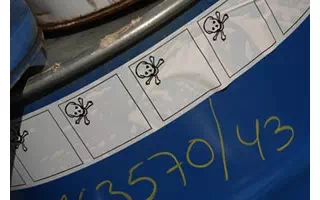 Labeling Labeling
Proper
labeling of hazardous chemical and waste is extremely important to reduce
exposure,
prevent accidents and extra disposal costs.
OSHA's Hazard Communications Program (HazCom) covers
the labeling of hazardous chemicals in use. Once the chemical becomes a
hazardous waste, a different set of labeling rules apply under EPA's RCRA
program. To add to the challenge of labeling all hazardous
materials, to prepare hazardous
waste for shipment, another set of rules apply under the Department
of Transportation (DOT).
HazCom requires that all containers of hazardous chemicals
must be labeled, tagged, or marked with the identity of the material and
appropriate hazard warnings. Chemical manufacturers, importers, and
distributors must ensure that every container of hazardous chemicals they
ship is appropriately labeled with such information and with the name and
address of the producer or other responsible party.
The primary information to be obtained from an OSHA-required
label is the identity for the material and appropriate hazard warnings. The
identity is any term which appears on the label, the SDS, and the list of
chemicals, and thus links these three sources of information. The identity
used by the supplier may be a common or trade name ("Black Magic Floor
Cleaner"), or a chemical name (1, 1, 1 - trichloroethane). The
hazard warning is a brief statement of the hazardous effects of the chemical
("flammable," "causes lung damage"). Labels frequently
contain other information, such as precautionary measures ("do not use
near open flame") but this information is provided voluntarily and is
not required by the rule.
Labels must be legible and prominently displayed. There
are no specific requirements for size or color or any specified test.
Proper labeling is extremely important to prevent accidents
and extra disposal costs
- Ensure proper labeling of all incoming materials as
they are received (Include product name, weight, concentration, lot number,
date, hazard class and any other information useful in tracking material
location, quality, age or use.)
- Always label hazardous waste at its point of generation
where it can still be easily identified (Testing contents later is expensive.)
- Label all areas in the plant, including stationary tanks,
pipelines, etc. containing hazardous materials or wastes
- If a chemical was in a labeled container and is subsequently
transferred to another container, the employer must label the new container.
- Shelving where the chemical is stored may be labeled
with additional labeling if when the chemical is removed from the labeled
shelf, it will be used in its entirety. If not, it will require an additional
label.
Specifically, HazCom requires the following types of information
to ensure that labeling is properly implemented in your facility:
- Designation of person(s) responsible for labeling system
implemented throughout the facility
- Designation of person(s) responsible for ensuring labeling
of all containers in each department/area
- Designation of person(s) responsible for ensuring re-labeling
of hazardous waste or to prepare waste for shipping
- Description of labeling system(s) used and comprehensive
training program
- Description of written alternatives to labeling of containers
(if used)
- Procedures to review and update label information when
necessary

|

